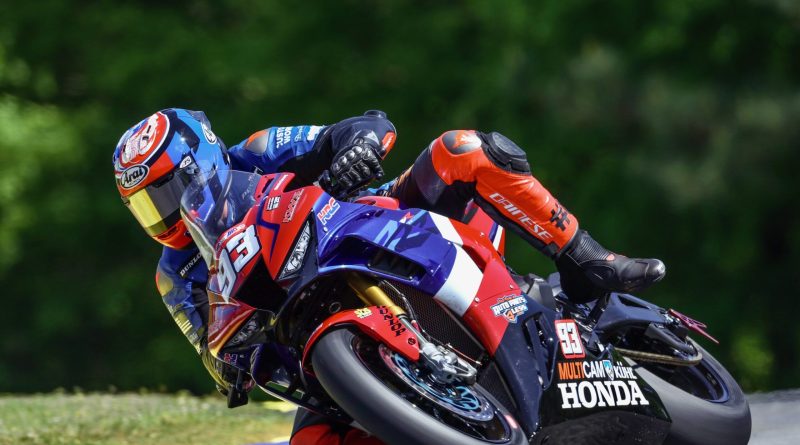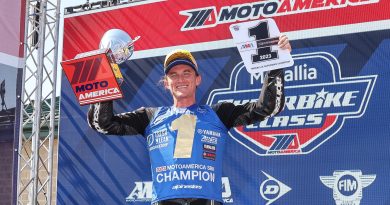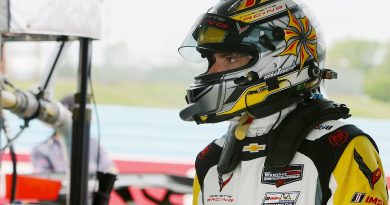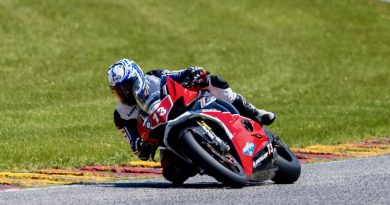The Zen Of Zendejas: A Soldier’s Story, Part Two
Zendejas’s leathers, helmet, and livery are red, white, and blue. The perfect color combination for a true America hero. Photo by Brian J. Nelson.
In Part Two of our interview with Luie Zendejas, we talk about some of the challenges that he has faced, how that has prepared him for racing in the MotoAmerica series, and who are some of the people in his inner circle. Here’s more from a true America hero.
Are you a disabled veteran?
Yes.
At MotoAmerica. we’ve worked with some disabled veteran groups. Is yours a physical disability?
Yes, I’ve got a total shoulder replacement, head trauma (TBI), compressed disks in my lower back and neck, limited range of motion in my left shoulder, limited range of motion in my right hip, hearing loss, my right leg is an inch shorter… the list goes on and on. Everything from overpressure from explosives for so many years, being too close to someone shooting their rifle right next to you, shooting anti-tank weapons, being really close to exploding charges. Jumping (military free fall) takes a toll on your back, knees, and neck. Wearing your helmet adds an extra toll on your body. I’ve been wearing a helmet since I joined in 1992, until I got out in 2016. Between all the units I’ve been in, I’ve done roughly 15 combat rotations, which seems like a lot, and it is, but there are guys in my peer group that are well over 25 to 30. To put it into perspective: you’re wearing your helmet with night vision, battery pack, light, and any additional gear you have, and you’ve got at least 14 to 15-plus pounds on your head every night, in addition to your body armor and weapon system, compressing your neck. Sometimes you’re flying in the helicopter anywhere from 25 minutes to an hour or more to a target, and then flying another 25 to 60 minutes back to base, and you’re doing this every night. During some rotations, we were going out once, sometimes twice a night. We’d do a mission, and then turn around and go right back out again for a follow-up mission. Every night for six to eight hours a night, sometimes longer if things went bad, and this for the entire three-to-four-month deployment. Your body is constantly getting thrashed, and then, add 20-plus years, and what you end up with is a worn-out chassis (body). I had a total right shoulder replacement in November, and at the end of January, I didn’t even know if I was going to be able to ride a motorcycle. I’m currently out there riding at 65% strength right now. It gets better every week, and again, no excuses. I know my target environment. I know what I need to do. I’ve got some awesome coaches, and we’re moving forward. So, there’s nothing to complain about. I don’t see myself as a disabled veteran, but trust me, my body reminds me every day. It’s just a post-military life we all deal with in different ways, and we’re the type of people who don’t like to complain about it.
It’s kind of going back to my perception of you as being an over-achiever and your perception is you’re just one of many over-achievers who are together, so you feel kind of average from that point of view. There are a lot of disabled veterans, and you’re one of them. Is that a fair assessment?
100%.
This thing about motorcycles and the military, it’s funny how they kind of started at the same time a little bit. Maybe one a little bit before the other, but you’ve kind of kept both of those things in your life pretty strongly together and you’ve managed to do it through the military. Motorcycling and riding bikes within the military, I know a lot of people in the military that ride motorcycles. Would you say that’s true?
Not really. I don’t know a lot of people. When I joined the military when I was 17, I didn’t have a motorcycle, I sold everything before I joined and to pay down that credit card my parents didn’t know about, so I didn’t own another one until 2000. So, there was a big spread where I didn’t have the money or the means to own a motorcycle. It was almost a 10-year gap.
So, you came back to it?
Yeah, I did come back to it. When I was a little kid, my parents didn’t have any money. I remember going to church and getting free cereal and cheese that people would donate so we could have some food at home. My dad would have just enough money to get us to school. It was hard. I remember watching a motorcycle race on TV and I was like, “Man, that’s super cool. That’s what I want to do.” My dad told me, “That costs a lot of money. We don’t have the money to do that.” Eventually I realized, if you want to be a road racer, you got to know someone or have the funding, and ideally start young. This is a privileged sport, and I’m grateful for the opportunity to race and share this with another generation of young kids – so no matter where they come from, they can do this too. It’s not easy, and it doesn’t always work out. I’ve also experienced this in the military; guys who did everything possible and sometimes out of accident or injury, sometimes just timing, didn’t get to do what they wanted. You just have to do the best you can every moment.
It’s interesting that you are the right person for it. I’m trying to understand what it is about you that has made you the right person for it.
All I can say is there is selection process to be a Ranger, a Green Beret and to be in the Unit. All are different and I won’t talk about the process. I will say this: just because you have all the qualifications and have been to all the cool-guy schools doesn’t mean you’re the right guy. There’s a saying in the Unit, “selection is an ongoing process.” Just because you made it doesn’t mean you’re staying. You can be in the Unit for 13 years and be at the top of the food chain, but if you mess up once, you’re gone. There are no second chances. Being part of that organization is like if the Dallas Cowboys franchise and MotoGP had a baby, and up it two-fold. That is the level of that organization. I remember when I finished selection, after I did all the physical stuff, there was a board I had to attend to see if I was going to be selected. They ended up screaming at me and told me to get out of the room. I walked out of the room and I’m like, “OK, well, I’m definitely not getting selected. I guess I’m going to be an instructor at Green Beret school.” Then they called me back. They were all the senior enlisted leadership from within the organization. They all stood up and said, “Sergeant Zendejas, welcome to the Unit.” And they all shook my hand. Then they walked me over to a door leading to another room where there was a supply guy there with a bunch of equipment, and all he did was size me for my helmet, for my boots, everything. The first day when I showed up to operators training course, everything that I was issued was brand-new. Brand-new uniforms, brand-new luggage, brand-new assault vest, brand-new body armor. I got issued my brand-new Heckler & Koch 416 assault rifle, brand-new, never fired. All my optics were brand-new. I got issued two Caspian 1911 match pistols. Never fired, brand-new. Just surreal! Anyone who has ever been in the military will tell you that you don’t get issued new weapon systems when you show up. It was the most special place on the planet to work. If I wanted something done to my weapons system, I just went to the arms room, “I want this, I want fiber-optic sights on this, I want to do this to that.” No questions asked, they did it. Everybody was there to support you, the operator. It was the most amazing place, however the hardest place to get into but the easiest place to get kicked out of. Even a speeding ticket was questionable. Your decision-making process was questioned. In my section, there was a time that, if you missed a shot, it wasn’t unheard of to lose a bit of your pay for that month or, depending on how bad you missed, you were fired. You get held at a standard that is so high that you’re just on your “A game” all the time. That gate to work would open up in the morning, and I would say to myself, “God, just let me be average today,” because every day, those guys were just trying to up their game up all the time. These days, it’s hard because you leave that type of organization when you retire, and you come to see that the world doesn’t operate at that level of accountability.
You have thrived in high-pressure situations. Racing is pretty high-pressure, especially like you were saying on the starting grid, that whole thing. It sounds like you enjoy the pressure being put on you.
100%. It keeps you alive. It keeps you sharp. The older you are, the harder you have to work at it. That’s the fun thing about road racing. It’s going to be hard to ever go back to club racing because club racing is so easy compared to the MotoAmerica stuff. Doing six to eight laps at the club level is one thing but doing 14 laps at my age and holding the pace at the very end, you have to put the work in for it. You’ve got to eat right. You’ve got to get your rest. You’ve got to look professional; this is “The Show.”
Let’s talk about you in our series and the teams you’re involved with. You’re one of only a few riders who are racing a Honda. Obviously, Geoff May is one of them. Jason Waters is another. They are kind of your teammates, or at least Jason is. You guys are both with Edge Racing. What is Edge Racing? Is Jason Waters your teammate and is Geoff May also your de facto teammate?
I was the first one to get the Honda, about a year and a half ago. Prior to that, I was on the BMW. I got the Honda just as one of those things. Then I told Geoff about it. I’m like, “Dude, this bike is really good.” He rode it and he’s like, “Yeah, this thing is legit.” He ended up getting one. Michael Godin has been my mechanic since 2009. We started as friends at the shop, then he would go help me out a club race from time to time and then it became a yearly thing starting in 2010 when he started going club racing with me. Every time I would go club racing, I wouldn’t be without him. So, Michael Godin has been part of my racing career since 2010. Then Geoff came back in the scene and started doing the MotoAmerica stuff, and Mike was like, “I’m going to go help Geoff out.” I was like, “Go for it, man. You’re a badass crew chief and you need to be out in the national stage to show what you can do.” I totally understand. I would want that for Mike to be racing with Geoff. Then obviously he did a couple stints with Geoff last season. If he wasn’t doing stuff with Geoff, he would help me out at the club scene. At the end of the last season, Jason kind of hit me up. I think we were at Barber, and we were talking and he’s like, “Hey, would you be interested in probably doing this next year? I think with both our heads, because we’re kind of the same skillset, we can really help each other out as teammates and move forward.” I go, “The only way I would ever consider doing this is if we were on the same machine, because it’s hard if you’re on different bikes, otherwise the only thing left to talk about is how the track flows.” So, we left it at that. Then I went out and did some military contracts out on the west coast. Next thing you know, he bought a Honda. I’m like, this guy is serious. We rode them in November, right before my shoulder surgery, and he’s like, “This bike has a lot of potential.” So, I go, “Hey, let me see how my surgery goes and if everything looks good, I’m in.” I had my surgery, and right after I told him “There’s no way I’m going to be able to ride. This is painful.” I literally couldn’t move my arm for three months. I had to keep it in the sling for two months. Then after I got out of my sling, I had to go to physical therapy just to get the range of motion back. That was another month. So, now we’re dipping into end of January. I talked to my doctor and I’m like, “Hey, I want to try to ride in the middle of February,” and he’s like, “You are crazy.” I’m like, “Let me just do one lap, and if everything feels messed up, I’ll come in.” So, we went to Jennings, and it wasn’t pretty, but there was potential. I went back there again three more times, it got better and better. That’s when I told Jason, I think I can do this. So, we started moving forward. Then we did a track day at Road Atlanta before the MotoAmerica event, and I could only do about four or five laps. I was like, there’s no way I can do the MotoAmerica event. I’ll probably have to get somebody on the bike for the first round. Then some of my military buddies called me up and they were like, “Hey, you need to come up with a course of action, come up with a plan, and execute it.” That’s exactly what I did. I went out there and settled into the rhythm and had no problem finishing the race. Things are looking better for VIR. Basically, that’s how The whole Honda and Edge Racing team evolved.
I would imagine you have to credit your military career and your training for helping you get back to where you are after your shoulder replacement.
Yeah, 100%. It’s all mental, knowing what your capabilities are, your support structure, and most important planning your execution and lastly rehearsing it to accomplish the mission. The whole Edge Racing thing, Jason has an air conditioning company called Edge Air Conditioning. I’m like, “Hey, man, you’ve already got canopies and everything from last year. Let’s just keep it as Edge Racing, and that way it’s just simple. We don’t have to go buy new stuff and spend money on things that aren’t necessary. So, that’s where the Edge Racing came in. As far as Godin and Geoff, we are all in the same family. We help each other out. If I find something out, I go to Godin. I go, “Hey, man, this is what the traction control is doing. I tried this, and the wheelie setting did this.” Or “Hey, Mike, I need help.” If he’s not really busy with Geoff, he’ll come help me. At Road Atlanta, he kept coming over and just checking on me. I’m his boy. I’ve been with him for all these years. The reason I’m road racing at this level is because of Mike. We’ve grown up together, so he’s always checking on me and making sure I’m OK.
It’s the reason that KWS Motorsports is right on the front of your leathers, obviously.
100%.
A couple things about Mike. You were saying 2009. Wasn’t that right around the time that he was working on that project with Chaz Davies and Ben Thompson, that Aprilia deal?
Yeah, he was kind of helping me out in ’09. Then in 2010, they weren’t doing the AMA anymore, so Mike was back at the shop. He did a couple of rounds with me that season before I pushed out to Afghanistan to do a rotation. I was overseas and missed the rest of the season, but GNF was happening in October, and since we were scheduled to deploy back to the States two weeks after GNF, I asked my leadership “hey, there’s the Grand National Finals” (and GNF was kind of a big deal back then). He was sold and was like “Hell, yeah! I’ll send you back home so you can do your GNF.” I was in disbelief, and to top it off, Kevin Hunt, owner of KWS, wanted to do something cool for me for this last round … so they built this bored-out GSX-R1000 with like 225 horsepower. It was ridiculous. No traction control or anything. I flew back from Afghanistan, did the GNF, had a great time. Then I was back at work on the next day on Monday morning and found another rotator (chartered aircraft) going back to Afghanistan. I called up the boys and was like, “Hey, there’s a rotator going out tonight. Can I jump on it and get back with you guys and get back in the fight? They’re like, “Dude, we’re going to be home in a week and a half.” I’m like “So?” I called my Squadron Sergeant Major and he said “Yeah, man. Go for it.” So, the day after GNF I flew back over there and got back into the fight for another week and a half, and then flew home with all the boys.
What is Knights Armament?
Knights Armament is a weapons company (carbines, night vision scopes, etc.). Knights Armament is the weapons company that makes some the 762 carbine rifles for the Marine Corps, the Navy, and the US Army. The Knights SR-25 was the weapon that I used overseas as a sniper. It’s a 7.62 caliber weapons system. That SR-25 was being phased out to the M110, which everybody has now. I went down to Florida to do a lot acceptance, where I basically shot the weapons to make sure they were to standard and whatever weapon was shooting really, really tight, we would move it aside or write down the serial number, so those weapons would be allocated only to our snipers. I met the owner’s son, and we became friends. One thing led to another, and he helped me out when I was club racing. Then we just became really good friends. They don’t really give me any monetary sponsorship, but I still wear it as a thank you for their support when it was really needed.
What is MultiCam?
MultiCam is the camouflage pattern that you see on everybody now. Back in ’04 and ’05, the Army had this digital pattern. The Navy had a digital pattern. The Air Force had a bunch of digital patterns. The Unit was the first guys prototyping this camouflage pattern called MultiCam. So, in ’05 I was wearing this stuff and people would see me out there and they’re like, “What is that? Who are you guys?” Then eventually the U.S. Army figured out, this camouflage pattern worked really well at night, in the daytime. It’s called MultiCam because you can wear that camo pattern in an urban environment, in a jungle environment, in a desert environment, and you can fit in. So eventually, the military is like, we want that. Now everybody wears the MultiCam pattern. The story behind the MultiCam pattern is the designer and the inventor, we became friends, and they kind of helped me out a couple years ago. They did a cool little video on Team MultiCam. A lot of the Team MultiCam guys are ex-veterans. Again, I wear it because I’m proud to be associated with those guys because that pattern has probably saved so many people, and there’s a lot of people at home right now because of that camouflage pattern.
The reason your name is Luie, and it’s spelled that way is because your name must be Luis, isn’t it?
It is. 100%.
So, you wouldn’t spell it “L-O-U-I-E” because your name isn’t Louis. Your name is “Luis.”
Yeah. There is a story behind my name. In second grade, I had a crush on this girl. She wrote me a note, and she wrote my name as “L-U-I-E.” And, from that day on, my name was Luie.
So, this is twice. You got involved in night school because of girls. You spell your name that way because of a girl. What’s going on with you? You’re married now, right?
Yeah. I married a “Ninja.” My wife Annaliese is a silver medalist women’s four-way formation skydiver. She used to compete in women’s four-way at the world level, as a member of the U.S. National Team. She earned her silver medal in Dubai. We met skydiving because if I wasn’t road racing, I was at the drop zone jumping because I was into high-performance canopy flying and angle flying, flying head-down and all that good stuff. I would go to these skills camps on the weekends if there wasn’t a road race. I noticed that the fine inputs that you give at canopy when you’re diving it down to earth and how fast the ground was coming, was kind of the same as you approaching an apex at speed on a motorcycle while on track. I’m like, “Wow, this is awesome.”
I’d get to the racetrack, and I’d be on pace in the first session because my eyes and my head were calibrated because I was jumping every weekend. So, I went to a boogie (skydiving event) in Eloy, Arizona, and she was an organizer there for an event called Sisters in Skydiving. So, it’s an all-girl event, and I’m there (imagine that). So, my buddy is a Red Bull athlete. Jeff Provenzano on the Red Bull Air Force team. He’s like, “Come over to my house. We’ll go jumping every day, and we’ll work out. It’s going to be a good time.” So, I took leave, and I did that. That weekend, this event was going on, and I met her. Then, after that, we just kept in touch, got married, and had a baby Frenchie (French bulldog) a few years later. Then, she was in business school and got her executive MBA. So, I’ve got this super-athletic, skilled chick with a brain for business. She’s like the perfect sugar-mama.
If somebody’s got an exceptional girlfriend or an exceptional wife, I generally like to compliment the guy on it. I’m like, “Nice job, dude. That’s the way to do it.” I know probably the other side doesn’t appreciate that too much, but I just feel so happy for the guys who land that special someone.
Yeah. Some guys get lucky, I guess.
For the full 2022 MotoAmerica schedule and to purchase tickets for MotoAmerica events, click HERE
For information on how to watch the MotoAmerica series, click HERE
The post The Zen Of Zendejas: A Soldier’s Story, Part Two appeared first on MotoAmerica.




